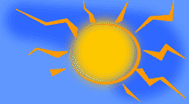In the Falklands we saw our best selection of wildlife. The islands are very sparsely
populated and penguins, sealions and birds have plenty of space and privacy. They are also quite unafraid of people and we
were able to get up close and personal. It's a windy old place and in Stanley the 4 mile fetch down the harbour meant we often
got ashore only once a week. It really is a little piece of England though with Tesco bread and baked beans coming by ship
and English papers twice a week. The local radio station played lots of country and western and one couple we met had a signed
photo of Daniel O'Donnell on their living room wall.
From the Falklands to New Zealand you sail the Southern Ocean by way of the five Great Capes - Horn, Good Hope, Leeuwin,
South East, and South West. It's a curious thing that the only one we were close enough to see from the boat was Cape Horn.
Some of the others we also visited by land. When people hear where we've been they always assume that we've seen some awful
weather and so we have but we've never felt threatened by storms at sea. Mithril is big and heavy and very comfortable and
in really awful conditions we leave only a tiny rag of headsail flying and retire below. The boat then seems to bob like a
cork with only the biggest of the waves coming aboard; while below we recline in comfort with a fire lit if necessary. It's
a fine experience to juke outside to look around at 50 degrees south and smell your own turf smoke. Stormy weather is much
worse near the land and dragging anchor in the Falklands saw us on the beach for 36 hours. There was no permanent damage but
the wary nervousness of anchorages lives on.
In Cape Town we had a spectacular berth beneath the towering Table Mountain. We did a lot of interior maintenance there
and a lasting memory is of gin and tonic at the end of the day listening to the call to prayer from the local mosque and being
mesmerised by the table cloth cloud cascading like a waterfall down the mountain. We also crewed for a weekend on a big plastic
racing boat and it was great fun to have someone else make decisions about reefing and bear the financial consequences of
any error. Our longest passage has been 63 days from Cape Town to Fremantle in Western Australia. We both like long voyages
and don't get bored or tired of the empty ocean. Birds are great companions then flying close to the boat to see what we are.
Sometimes you even get to tell individual birds apart especially the giant wandering albatross which may make a daily visit
over the whole course of a passage.
Landfall is always exciting and Australia was no exception. In all we've spent 18 months in Aussie, 10 of them travelling
by land. After 6 months by sea we'd been in 4 different ports on the mainland. It was unthinkable to leave after seeing so
little. Biddy the bus was a great find. A 17 year old van costing 200 pounds and we drove nearly 25,000 miles in it and still
sold it for 400 quid - not bad going that. Looking at a map to drive right round Australia is 22,000 kilometres and we reckoned
on doing about 25,000. In the event we did 42,000 kms. But we saw nearly all the highlights of the country - Uluru which used
to be called Ayers rock, Kakadu aboriginal art sites, Ningaloo reef, some of the tallest trees in the world and a lot of the
most unusual wildlife in the world from crocodiles and fruit bats to wallabies and wombats. We camped in the bush and often
cooked on an open fire. And best of all we never, ever had to even think about the weather.
Now we're back on the briny and in New Zealand preparing for the next part of our voyage. We will cross our outward track
at the western end of Magellan Strait but that completes only a short circumnavigation. It's not until we cross the equator
again that technically we've gone right round the world. It's been an eventful 10 years which has passed very quickly. We've
had some marvellous experiences and met loads of great people. Undoubtedly a boat is the only economical way of seeing the
world for an extended period and we don't regret our decision to take such a long time over doing it. Given the choice again
we would probably build the same boat - certainly not one much smaller. An aluminium hull would be lighter and much easier
to maintain but more expensive and awkward to build. So what's in the next 10 years for "Mithril"? We would expect to arrive
in Northern Ireland in the summer of 2002 after a non-stop passage from Chile and then we might have another go at the Caribbean
before going round the world again by the warmer trade wind routes. We certainly won't be hanging up the anchor just yet.
Email in particular has changed the way we do things in the last decade and we get to keep in touch with many more people
much more easily. No matter how long it is between cyber cafes or how often we change from our intended track missing mail
is no longer a problem. Thank you for your emails over the years; we cherish them all.
Back to Top
Return to archive menu
